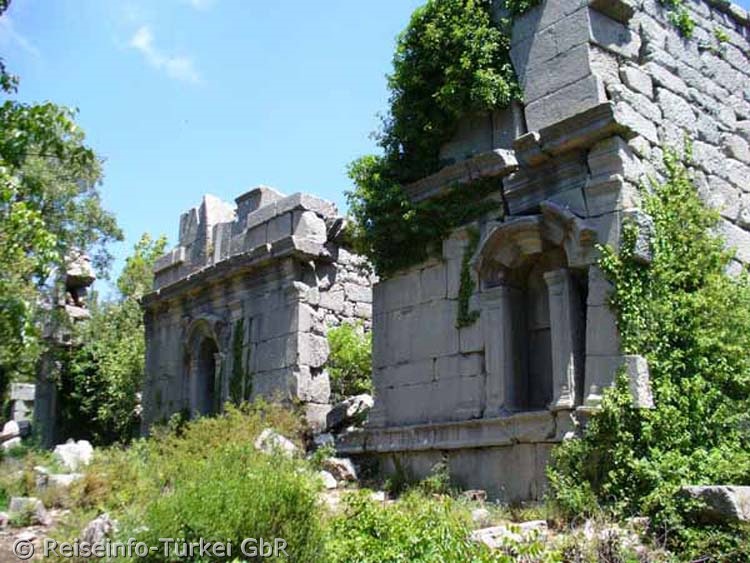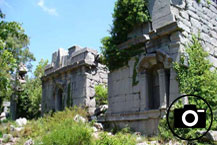|
Holidays on the Turquoise Coast |
|||
|
Ancient city in the mountains near Antalya |
This could also be of interest to you
|
|||||
|
Termessos |
||||||
|
The city Alexander the Great himself failed to reach |
||||||
|
|
||||||
|
The ancient city of Termessos is located approx. 35 km northwest of Antalya at an altitude of approx. 1000 metres in the middle of a magnificent mountain landscape. From the park entrance at the D350, the connecting road from Antalya to Fethiye or Denizli, a narrow road leads over serpentines for approx. 8 km to the parking lot in the lower area of the ancient city. |
||||||
|
|
||||||
|
Next to today's parking lot stood the temple for the Roman Emperor Hadrian, from whom the portal was erected again. Hadrian had visited the city in 130 AD. The temple was built in his honour. |
||||||
|
|
||||||
|
Today a narrow, stony and quite steep path leads up to the upper town. At that time the main street, the so-called "royal road". |
||||||
|
|
||||||
|
Passing imposing remains of the city wall, the royal road leads to the city gate. One slowly gets an idea why the army of Alexander the Great could not take the city. |
||||||
 |
||||||
| The front of the baths of Termessos | ||||||
|
Passing the strong remains of a palace wall on the left side of the mountain you reach a small plateau on which the stadium, a well-preserved gymnasium and the cistern-fed baths of the city were built. |
||||||
|
|
||||||
| The Stadium | ||||||
|
Opposite the baths and the gymnasium was the stadium, of which only the remains of the supporting structure for the rows of seats remain today. Earthquakes and landslides have been a major problem for the building over the centuries. |
||||||
|
|
||||||
|
For most visitors, the city's beautifully situated theatre is the highlight of the tour. It is difficult to resist the fascination of this site and its location opposite the Güllük Dağı (mountain of roses). |
||||||
|
|
||||||
| According to the shield, a Corinthian temple and portico of Attalos, king of Pergamon and founder Antalyas | ||||||
|
In summer, when the vegetation is in full bloom, the abundance of the preserved building remains, which are well worth seeing, is almost impossible to detect. In retrospect, one will always find that one has not seen or perceived this and that. In winter, when the trees have lost their foliage, you can see a little more, but without the park administration of the Güllük Dağı Millî Parkı clearing the undergrowth for the umpteenth time, even the attentive observer misses a lot. A hopeless fight, time and time again. |
||||||
|
|
||||||
| The Bouleuterion and the adjacent Zeus temple (front) | ||||||
|
The Bouleuterion / Odeon (town hall) from the first century A.D. is with its almost 10 meters height from the outside still a powerful appearance. However, the interior is filled with debris and sediments blown into it. Coloured marble pieces found here could indicate that the interior walls were covered with marble. |
||||||
|
The plateau around the Bouleuterion was the centre of the city. No less than six temples and one heroon were here. |
||||||
|
|
||||||
|
It is still unknown to this day who was especially revered there, usually the legendary founder of the respective polis. Perhaps in the coming decades, once Termessos is systematically researched, archaeologists will find indications of this person. |
||||||
|
|
||||||
|
On the slopes and rock walls around the city there are extensive necropolises with hundreds of stone sarcophagi and partly artistically worked rock tombs. |
||||||
|
According to old traditions, the town of Termessos already existed in the 7th century B.C. The town made a name for itself by plundering pamphil cities in the plain. |
||||||
|
You can reach Termessos as follows:
With the rental car: By bus: |
||||||

